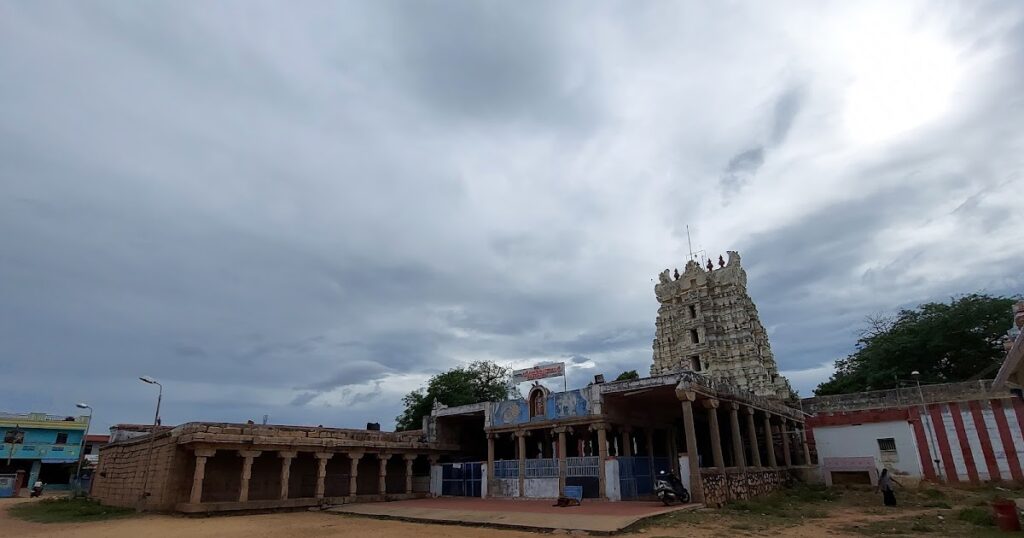In the previous episodes of this series, I explored the extraordinary life-size sculptures housed within two mandapas of the Krishnapuram Venkatachalapati Temple, each pillar telling stories in stone with a finesse unique to the Nayaka period. In the previous article, I also traced the historical roots and inscriptions that reveal the temple’s founding and sustenance.
With this final episode, I now shift focus to the presiding deity, subsidiary shrines, and the architectural spaces that complete this magnificent temple.
.jpg) |
| Krishnapuram Temple |
🛕 The Temple Layout and Entrance
The east-facing temple welcomes visitors with a gigantic five-tiered rajagopuram, a towering gateway that announces the grandeur within. Leading to this tower is a long covered pillared mandapa, where stone and light interact with quiet majesty.
The base of the rajagopuram is richly detailed:
-
Miniature shrines, vimanas, and kumbha panjarams
-
Horse-shoe-shaped elements and small relief figures
-
Decorative motifs typical of Dravidian temple architecture
The massive wooden doorway beneath the gopuram, timeworn yet intact, forms a dramatic entrance into the sacred precinct.
🌟 The Presiding Deity – Venkatachalapati
The main sanctum (garbhagriha) enshrines Lord Venkatachalapati, standing about 4 feet high, in a four-armed posture, accompanied by his consorts Sri Devi and Bhoo Devi. The deity radiates grace and stillness—a divine presence at the heart of Krishnapuram.
Also housed in the same sanctum are:
These utsava murtis are worshipped during processions and festivals, complementing the stone moolavar.
🧱 Mandapas and Sacred Architecture
The temple follows a classic layout, progressing through a series of beautifully structured mandapas:
-
Ardha Mandapa – Leading directly into the sanctum; flanked by moderate-sized Dwarapalas.
-
Maha Mandapa
-
Mukha Mandapa – As detailed in earlier episodes, this hall features life-sized sculptures on every pillar. Above these pillars, the upper portions of the wall have miniature panels, most notably:
-
Depictions of Vishnu in reclining posture (Ranganatha).
-
Variations include with or without Lakshmi, with or without Brahma, and other narrative details.
-
Other depictions of Vishnu like Paramapatanathar and Vishnu in the standing posture.
-
-
Mani Mandapa – At the entrance, two large stone Dwarapalas guard the hall with imposing presence.
Facing the sanctum from the eastern axis are:
-
Garuda Mandapa
-
Dwajastambha (flagstaff)
-
Bali Peetha
These ritual elements align the outer and inner spaces, leading devotees inward, both physically and spiritually.
🌸 Subsidiary Shrines and Devotional Icons
🔸 Inner Prakara (Circumambulatory Path)
-
A shrine houses the icons of the twelve Alwars
-
Viswaksena, the commander of Vishnu’s army
-
Sri Ramanuja, the great acharya of the Sri Vaishnava tradition
These icons underline the theological and devotional framework of the temple.
🔸 Outer Prakara
In the outer prakara, two prominent shrines are dedicated to:
-
Alarmel Mangai (Alamelu)
-
Padmavati
Both goddesses are seated in majestic four-armed forms, facing east. Each shrine is fronted by a long and elegantly designed mandapa, testifying to the temple’s architectural harmony.
(Sidenote: While Padmavati is traditionally worshipped in Tiruchanur and Alarmel Mangai is associated with Tirumala, their presence in Krishnapuram reflects the integrative tradition of Sri Vaishnavism.)
🧘 Concluding the Series
With this final episode, I conclude the Krishnapuram Temple Sculpture Series. From life-sized masterpieces carved in stone to inscriptions etched into time, and from the towering gopuram to the intimate inner sanctum, this temple remains a living gallery of Nayaka artistry and Vaishnava devotion.
May these records guide future visitors, scholars, and heritage enthusiasts in experiencing Krishnapuram not just as a temple, but as a repository of sculptural and spiritual excellence.
Happy travelling.
This is Part 13 of the series of articles on Krishnapuram Temple. If you are interested to read the earlier parts of the series, click the links below.
Part 1
Part 2
Part 3
Part 4
Part 5
Part 6
Part 7
Part 8
Part 9
Part 10
Part 11
Part 12

